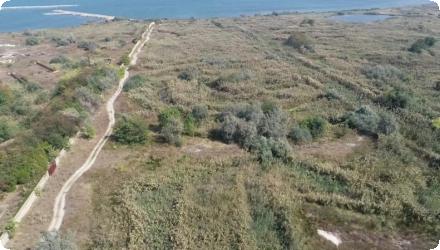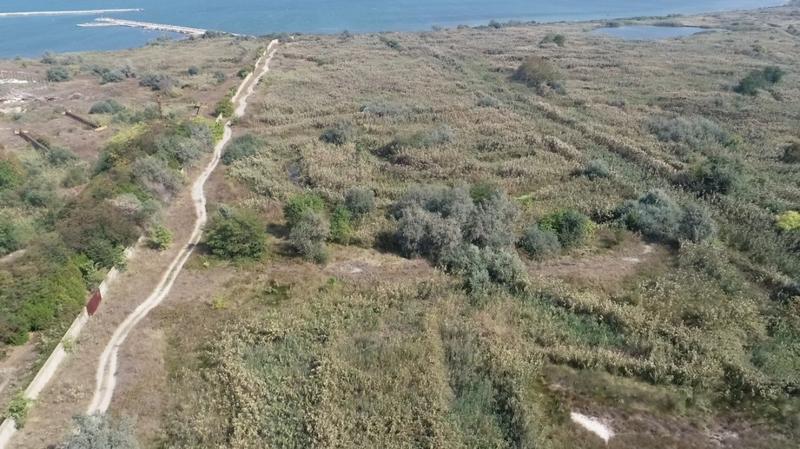Last update
2025
Summary
Life for the Burgas Lakes (LIFE08-NAT/BG/000277) was an EU LIFE+ Nature project aiming to secure the long-term conservation of five Annex I bird species and the sustainable management of their wetland habitats around Burgas, implemented in coordination with Burgas Municipality, Chernomorski Solnitsi (Black Sea Saltworks), the Bulgarian Biodiversity Foundation and RSPB (2010–2014). Since then, complementary measures across the complex have consolidated and expanded results: at Poda (Ramsar), works in 2023 reopened the Komlushki canal, rehabilitated a dyke and installed water-level control; at Lake Vaya, the outlet canal to the Black Sea was rehabilitated in 2023 to increase hydraulic capacity, rebalance salinity and improve the water regime; at Atanasovsko Lake, the Salt of Life and Lagoon of Life projects (2012–2018; 2018–2024) restored dikes, cleaned saltwater channels and enhanced lagoon habitats, with Bulgaria’s first successful Greater Flamingo breeding recorded in 2024. Grid-related bird mortality is being addressed by the ongoing LIFE “Safe Grid for Burgas” (2021–2026). According to the project manager, most NWRM remain operational and continue to deliver benefits to birds, with natural transformations and targeted upgrades.
Position
Latitude
42.5775
Longitude
27.454
Project
NWRM
National Id
Bulgaria_05
Installation date
2012-12
Implementation Status
Contact
REC
RBD code
BG2000
Transboundary
0
Photo gallery
Location of the project
Atanasovsko Lake, on the north side of Burgas. The Burgas–Varna main road (E87/I-9) cuts the lake into north and south basins.
NUTS Code
BG34 - Югоизточен (Yugoiztochen)
Project's objectives
Restore/manage habitats: Repair dikes at Atanasovsko; deepen lagoons (Atanasovsko, Poda-Mandra); cut reed for Bittern/Ferruginous Duck; create roost/nesting sites for pelicans and cormorants; predator control on key dikes. Planned reed cutting 48 ha
Involved Partners
| Authority type | Authority name | Role | Comments |
|---|---|---|---|
Climate zone
warm temperate dry
Temperature
12.3 °C
Precipitation
560
Annual rainfall range
300 - 600 mm
Elevation range
10 m
Slope range
0.0
Vegetation class
reed and bulrush, grasslands and marsh plants
Water bodies: Ecological Status
Bad
Water bodies: Chemical Status
Failing to achieve good
Water quality status
Petroleum products, phenols and other chemicals from the nearby refinery, plus agricultural pesticides and fertilizers causing eutrophication. 2015 pipeline rupture released up to ~40 t petrol into a Burgas lake.
Project scale
Meso
Project scale specification
This project targets the Burgas Lakes complex around the city of Burgas—not a single plot but a regional/metropolitan wetland system including Atanasovsko Lake and the wider Burgas lakes (Vaya/Mandra-Poda), with actions on dikes, canals and water-level control across multiple Natura 2000 sites. The NWRM record itself flags the application scale as “Region” (area noted ~10,600–12,285 ha, with ~4 ha of direct restoration works), and LIFE project materials describe work across the Burgas lakes, not just one locality.
Performance timescale
5 - 10 years
Project area
10600
Area subject to Land use change or Management/Practice change (ha)
4
Size
12285
Size unit
ha
Design capacity description
4 ha (actual area of the restoration works)
Difficult access for mechanization; Soft soils
Deepening of existing wetland
Total cost
€ 1,775,006
Costs total information
Total budget
Costs investment
200000
Costs investment information
Budget of the actual restoration works
Financing authorities
Type of funding
EU-funds: LIFE+
Type of funding
EU-funds: LIFE+
Comments
LIFE20 NAT/BG/001234 – “LIFE Safe Grid for Burgas” (2021–2026)
Total eligible budget: €5,492,571; EU contribution: €4,119,428.
Total eligible budget: €5,492,571; EU contribution: €4,119,428.
Compensations
0
Policy context
Around Burgas, coastal wetlands (Atanasovsko, Vaya/Mandra–Poda) faced habitat degradation and disturbed hydrology (dykes/canals damaged by floods), disturbance/poaching, bird mortality on power lines, and pollution/eutrophication from nearby industry and agriculture. These map to WFD-relevant pressures: hydromorphological alteration (embankments, silted canals), point-source/industrial and diffuse-agricultural pollution (nutrients, chemicals), and risk from accidental spills along the Vaya–Black Sea canal.
Land ownership
Mostly publicly owned (over 90% state owned, rest municipality or private)
Community involvment
Yes
Design consultation activity
| Activity stage | Name | Key issues | Comments |
|---|
Policy target
| Target purpose |
|---|
|
Improved Biodiversity
|
|
Pollutants Removal
|
|
Oher Societal Benefits
|
Policy pressure
| Pressure directive | Relevant pressure |
|---|
Policy impact
| Impact directive | Relevant impact |
|---|
Requirement directive
| Requirement directive | Specification |
|---|
Contractual arrangements
0
| Arrangement type | Responsibility | Role | Name | Comments |
|---|
Part of wider plan
0
Wider plan type
| Wider plan type | Wider plan focus | Name | Comments |
|---|
Continue regular hydrology/hydrochemistry and bird/coastal-habitat monitoring at site scale with clearly defined responsibilities and an active role for RIEW–Burgas post-LIFE.
Hydrology: water levels and salinity as core controls for lagoon functioning and active management.
Hydrochemistry: project docs indicate hydrological & hydrochemical tracking; studies list pH, dissolved oxygen, temperature, nutrients (NO₂⁻, NO₃⁻, NH₄⁺, total N, PO₄³⁻) and broader physico-chemical indicators.
Biota: birds (Annex I breeding/migratory species) and biological quality elements (e.g., phytoplankton).
Hydrochemistry: project docs indicate hydrological & hydrochemical tracking; studies list pH, dissolved oxygen, temperature, nutrients (NO₂⁻, NO₃⁻, NH₄⁺, total N, PO₄³⁻) and broader physico-chemical indicators.
Biota: birds (Annex I breeding/migratory species) and biological quality elements (e.g., phytoplankton).
Maintenance
Routine O&M focuses on keeping canals, sluices and dikes functional (dredging/cleaning, structural repairs) and actively managing water levels/salinity, led by RIEW–Burgas with BBF/Black Sea Salinas/BSPB and NGO support.
With new data 2013 are prepared maps for the potential and recorded breeding sites of importance for and distributions of the Bittern and the Ferruginous duck.
Visitor infrastructure & interpretation improved (hides, trails, signage) under LIFE08; Poda Nature Conservation Centre continues to operate year-round with guided visits and fees (eco-tourism revenue).
Works at Vaya (rehabilitated outlet to the Black Sea) reduce hydraulic load and improve the lake’s regime - addressing past flood issues affecting adjacent urban/agricultural areas.
Works at Vaya (rehabilitated outlet to the Black Sea) reduce hydraulic load and improve the lake’s regime - addressing past flood issues affecting adjacent urban/agricultural areas.
Retained water
3,2
Retained water unit
mio m3/year
Information on retained water
25 ha restored by deepening; 18 ha improved by reed cutting (vs. 48 ha planned)
Increased water storage
80000
Increased water storage unit
m3/year
Runoff reduction
80000
Runoff reduction unit
m3/year
Water quality overall improvements
Positive impact-WQ improvement
Information on Water quality overall improvements
Improvement of oxygen and decrease of Chlorophyll-a after channel cleaning and dyke works (indicative of reduced eutrophication).
Soil quality overall soil improvements
Neutral impact-no change in SQ status
1
Observed 318 bird species, 241 vascular plants (Salicronia, Sea Wormwood, Typha, Suaeda, etc). Orchid. Endanger species like Otter. Salty part with micro scopic brine shrimp which give pink color to the water.
8 artificial islands + 10 roosts (332 m²); 796 bird diverters and 60 insulated poles on 8.8 km of lines; 14.5 km dikes/barriers further restored; poaching attempts reduced by 55%
8 artificial islands + 10 roosts (332 m²); 796 bird diverters and 60 insulated poles on 8.8 km of lines; 14.5 km dikes/barriers further restored; poaching attempts reduced by 55%
Ecosystem impact climate regulation
No information available
Ecosystem provisioning services
1
Information on Ecosystem provisioning services
The quantity of produced salt depends of the brine shrimp and the existence of the brine shrimp depends on the good management of the lake. The lake also provides medical mud and lye.
Key lessons
Coordinating a multi-site wetland system inside protected areas requires early, sustained buy-in from competent authorities. Permitting and legal alignments can be lengthy, and project teams must plan time for approvals and cross-agency coordination. The original NWRM record already stressed this, and project documents confirm the challenge of working under Natura 2000 regimes with multiple actors and contractors.
Pairing conservation with salt-production operations is a strength. When the saltworks maintain hydraulic infrastructure, biodiversity benefits follow; conversely, floods that destroyed >30 km of dykes showed how vulnerable the system is without continuous O&M. Aligning economic uses with habitat targets proved both feasible and beneficial.
Monitoring must go beyond birds. Post-LIFE guidance calls for continued hydrology/hydrochemistry and coastal-habitat tracking, with clearly defined roles and an integrated management plan.
Grid risks remain a system-level issue. Early mitigation helped locally, but the majority of hazardous power lines still require retrofitting or undergrounding, so long-term avian safety depends on continued investment.
Pairing conservation with salt-production operations is a strength. When the saltworks maintain hydraulic infrastructure, biodiversity benefits follow; conversely, floods that destroyed >30 km of dykes showed how vulnerable the system is without continuous O&M. Aligning economic uses with habitat targets proved both feasible and beneficial.
Monitoring must go beyond birds. Post-LIFE guidance calls for continued hydrology/hydrochemistry and coastal-habitat tracking, with clearly defined roles and an integrated management plan.
Grid risks remain a system-level issue. Early mitigation helped locally, but the majority of hazardous power lines still require retrofitting or undergrounding, so long-term avian safety depends on continued investment.
Success factor(s)
| Success factor type | Success factor role | Comments | Order |
|---|---|---|---|
|
Attitude of decision makers
|
main factor
|
1
|
|
|
Attitude of relevant stakeholders
|
main factor
|
2
|
|
|
Existing staff and consultant knowledge
|
main factor
|
3
|
|
|
Financing possibilities
|
secondary factor
|
4
|
Driver
| Driver type | Driver role | Comments | Order |
|---|---|---|---|
|
Organisation committed to it
|
main driver
|
1
|
|
|
Availability of subsidies
|
main driver
|
2
|
Transferability
Highly transferable to coastal lagoons and salt-pan wetlands where levels and salinity can be actively managed. Key cautions: tailor hydrological/salinity design; allow long permitting/coordination across authorities; plan sustained O&M of dikes, canals and sluices; mitigate power-line risks; address local pollution/eutrophication. Monitor not only birds but hydrology and hydrochemistry to verify benefits and adapt.
English


Total eligible budget: €1,775,006; EU (LIFE) contribution: €1,331,254